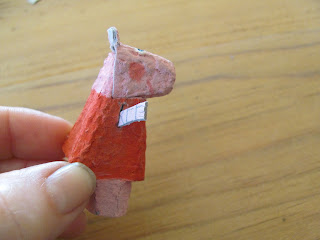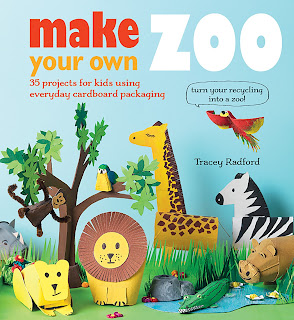Who'd have thought the Clangers and Peppa Pig had something in common? Well it turns out you can make both in a very similar way from an egg carton! Always good when one idea leads to another...
All you'll need is:
an egg carton
red and white paint
fine black felt tip or gel pen
red/pink felt tip pen or highlighter
general purpose scissors
Straight-edged nail scissors or similar (optional) Adult supervision needed
1. Roughly cut out as much of the two middle cones as you can from the egg box. This makes them easier to work with.
3. For the legs, cut up the middle of one of the sides, about a third of the way. Then wiggle and turn your scissors to cut across to the corner and just beyond. Do the other side too, so you've cut a sort of 'T' shape. Now repeat this 'T' shape on the opposite side of the cone.
4. To form the legs, press the cut card edges in the middle towards each other and squeeze each side into a rounded leg shape. If they're too big, snip off a small piece of card. There's no need to use glue. The legs should hold and the body should be stable. (Snip the bottom of the legs if the body is a little wobbly)
5. For the head, take the other egg box cone and use a pencil and ruler to mark about 2cm (3/4in.) from the top on all sides. Join the marks with a line. Choose which side you'd like for the face and draw small round Peppa ears here. Keep them on top - don't draw past the corners.
6. To help cut the head out, cut up the two back corners to the pencil line, fold the flap of card back and cut it off. It should now be easier to cut along the rest of the line, cutting carefully around the ears. With the little fiddly bit of card between the ears, either bend it forward and snip off or simply fold it behind so it's inside the head.
8. While that's drying cut a thin strip of card for the arms (about 5cm/2in. long) from the egg carton lid.
9. Painting time - paint the head, legs and arm strip pink (lots of white and a little red), and then the middle part of the body red for Peppa's dress. Don't forget to paint the top part of the cone pink at the back.
10. When dry, fold the arm strip in half and cut along the crease. Use small scissors to snip fingers in the ends if you like.
Then, either glue the arms on the sides, OR, use the nail scissors to make slots for arms either side (keep them closed, press down firmly and twist until the tip pierces through the card, then cut slots)
Wiggle the scissors in and out a few times so it's easier to push the arms in.
11. Use a pink felt tip or highlighter to draw circles for cheeks, the snout and nostrils, and a big smile. Dot two small white dots of paint for eyes on top, in front of the ears. When dry, finish the eyes with a spot of black felt tip or gel pen.












































